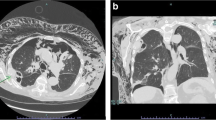Abstract
Background
Endoscopic thoracic sympathectomy (ETS) is now an established surgical technique for treatment of palmar hyperhidrosis that is performed under general anesthesia with positive pressure ventilation via either an endotracheal tube or a double lumen endobronchial tube. This is a bilateral disease that requires the division of the right and left thoracic sympathetic chain. The aim of this study was to compare the hemodynamic changes using a left capnothorax first versus right a capnothorax first surgical approach using a single lumen endotracheal tube in patients undergoing bilateral ETS. Lung collapse was achieved by carbon dioxide insufflation.
Methods
Forty patients of both sexes aged 18–30 years and of American Society of Anesthesiologists grade I were randomly assigned to undergo bilateral ETS. Patients were divided into two groups. Group L comprised left capnothorax first, followed by right capnothorax (n = 20). Group R comprised right capnothorax first, followed by left capnothorax (n = 20). The anesthesia technique was standardized for all patients. Cardiovascular variables were determined during the procedure every minute. Statistical analysis was performed by independent-sample t test and Pearson’s chi-square test.
Results
There was a significant (P < 0.05) mean percentage decrease in systolic blood pressure in group L compared to group R. Similarly, the mean percentage decrease in diastolic blood pressure in group L was significant compared to group R (P < 0.05). Seven patients in group L developed bradycardia, but this was not found to be statistically significant.
Conclusions
When the left capnothorax first approach was used, there was significant hypotension, compared to a right capnothorax first thoracoscopy. We thus recommend that right capnothorax should be performed first in cases of bilateral ETS.









Similar content being viewed by others
References
Drott C (1994) The history of cervicothoracic sympathectomy. Eur J Surg 5:572–575
Harris RJD, Benveniste G, Pfitzner J (2002) Cardiovascular collapse caused by carbon dioxide insufflation during one lung anesthesia for thoracoscopic dorsal sympathectomy. Anaesth Intensive Care 30:86–89
Prasad A, Ali M, Kaul S (2010) Endoscopic thoracic sympathectomy for primary palmar hyperhidrosis. Surg Endosc 24(8):1952–1957
Kellow NH, Scott AD, White SA, Feneck RO (1995) Comparison of the effects of propofol and isoflurane anesthesia on right ventricular function and shunt fraction during thoracic surgery. Br J Anaesth 75:578–582
Jedeikin R, Olsfanger D, Schachor D, Mansoor K (1992) Anesthesia for transthoracic endoscopic sympathectomy in treatment of upper limb hyperhidrosis. Br J Anaesth 69:349–351
Peden CJ, Prys-Roberts C (1993) Capnothorax: implications for anaesthetist. Anesthesia 48:664–666
Grichnik KP, Dentz M, Lubarsky DA (1993) Hemodynamic collapse during thoracoscopy. J Cardiothorac Vasc Anesth 7:588–589
Rozenburg B, Katz Y, Isserles SA, Baitman B (1996) Near-sitting position and two-lung ventilation for endoscopic transthoracic sympathectomy. J Cardiothorac Vasc Anesth 10:210–212
Wolfer RS, Krasna MJ, Hasnain JU, McLaughlin JS (1994) Hemodynamic effects of carbon dioxide insufflations during thoracoscopy. Ann Thorac Surg 58:404–408
Ohtsuka T, Imanaka K, Endoh M (1999) Hemodynamic effects of carbon dioxide insufflation under single lung ventilation during thoracoscopy. Ann Thorac Surg 68:29–33
Bitto T, Mannion JD, Stephenson LW (1985) Pneumothorax during positive-pressure mechanical ventilation. J Thorac Cardiovasc Surg 89:585–591
Brock H, Rieger R, Gabreil C, Moosbauer W, Necek S (2000) Hemodynamic changes during thoracoscopic surgery: the effects of one-lung ventilation compared with carbon dioxide insufflation. Anesthesia 55:10–16
Rutherford RB, Hurt HH, Brickman RD, Tubb JM (1968) The pathophysiology of progressive, tension pneumothorax. J Trauma 8:212–217
El-Dawlatly AA, Al-Dohayan A, Samarkandi A, Algahdam F, Atef A (2001) Right vs left side thoracoscopic sympathectomy. Effects of CO2 insufflation on hemodynamics. Ann Chir Gynaecol 90:206–208
Gustman P, Yerger L, Wanner A (1983) Immediate cardiovascular effects of tension pneumothorax. Am Rev Respir Dis 127:171–174
Lin ES (2003) Physiology of the circulation. In: Pinnock C, Lin T, Smith T (eds) Fundamentals of anesthesia, 2nd edn. Greenwich Medical Media, London, pp 348–351
Disclosures
Drs. Meera Kharbanda, Arun Prasad, and Ashish Malik have no conflicts of interest or financial ties to disclose.
Author information
Authors and Affiliations
Corresponding author
Rights and permissions
About this article
Cite this article
Kharbanda, M., Prasad, A. & Malik, A. Right or left first during bilateral thoracoscopy?. Surg Endosc 27, 2868–2876 (2013). https://doi.org/10.1007/s00464-013-2843-5
Received:
Accepted:
Published:
Issue Date:
DOI: https://doi.org/10.1007/s00464-013-2843-5




